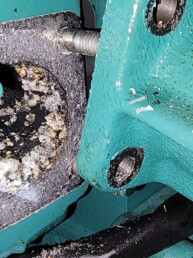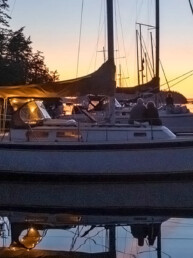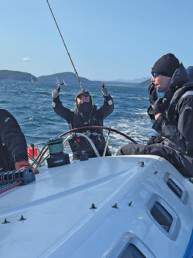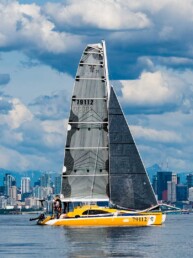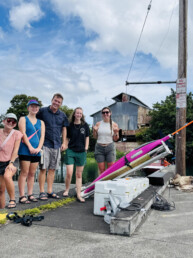The Broken Group is a wild world in miniature. Each tiny island looks like its own Bonsai arrangement, densely packed with driftwood, gnarled trees, and dangling moss. The closer you approach, the greater the detail that emerges.
This article, by Conrad Wharton, is from the February 2017 issue of 48° North.
It was mid April and still raining, even after two cups of coffee. It seemed miserable out, but we were motivated to make it to Ucluelet, most of the way to our spring cruising destination of Tofino. I reluctantly crawled into a set of full rain gear and got into the dinghy to retrieve our stern tie line.
We had spent a full day already baking, reading, and hiking through the clinging rainforest to the far side of Effingham Island. The only trail, marked by hanging buoys and other flotsam, stayed deep under the canopy until it popped out at an ancient midden. Moss was slowly beginning to cover the shells, and grasses and trees had already long-hidden an old longhouse structure. We followed the beach towards a sea cave, turning around at the entrance when we realized we had followed a set of wolf tracks there. The tracks zig-zagged along the tideline, following the smells of the beach from driftwood pile to driftwood pile. They didn’t lead back out of the cave.
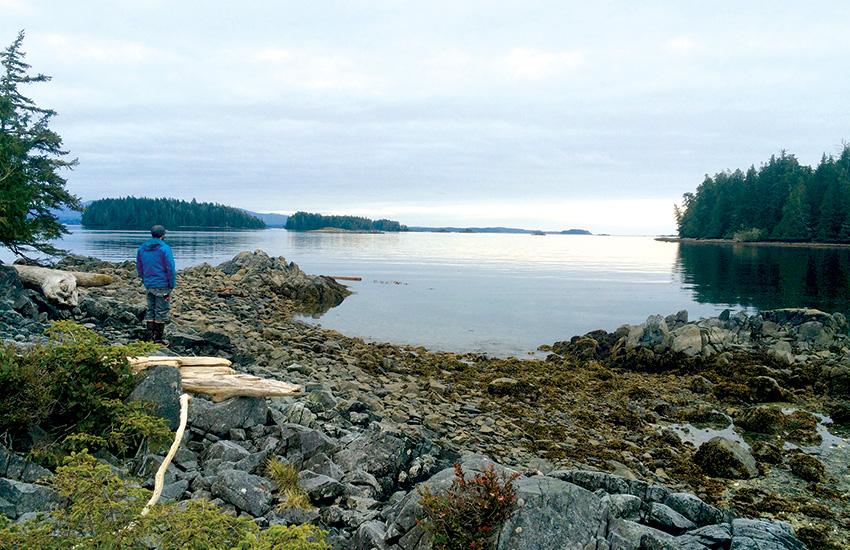
The West Coast of Vancouver Island is a wild place, despite its close proximity to Seattle and Vancouver. Barkley Sound, at the southern end, is the most accessible from a southern sailing route. However, its western part is isolated in most other ways, a long and expensive drive from the mainland.
At the southwest entrance to the sound, you’ll find the divided town of Bamfield. Bamfield is divided by two things: an inlet that wanders up the middle of the town, and feuding neighbors running over each other’s crab traps set there.
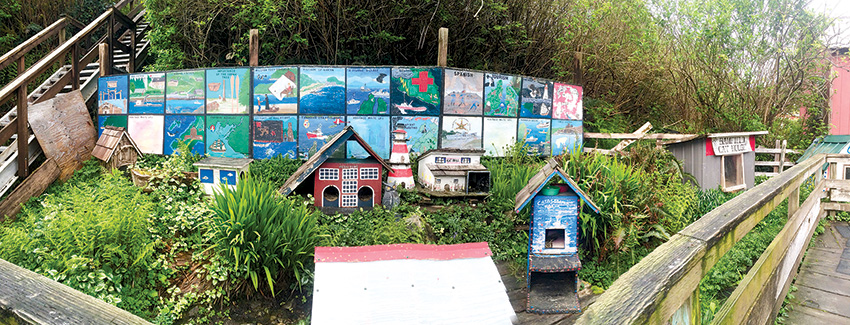
Show up in April, and here’s what you’ll find on your left (the side with a road): A large marine biology research center, a closed fuel dock, a hotel you can (and should only) stay in if your boat sinks, and a poorly stocked grocery store. On your right (water access): The Coasties, a well-stocked grocery store, eclectic housing for stray cats, and a fuel dock that’s open if you’re lucky. At the head: a WWII landing craft named the Black Pearl, driven by an extremely friendly, ex-drug-running tugboat driver and current salvage logger who will let you know where to anchor.
Sailing to the west coast in the off-season, we discovered, is an exercise in patience. Hunker down too early in anticipation of a storm, and you might miss a good travel window. Push too far, or leave shelter too early, and expect to be humbled.
In addition to the natural obstacles, bureaucratic and logistical hurdles present a few challenges. Clearing customs is best done by sailing to Victoria, and then westward in Canadian waters. Bamfield lacks a customs dock, and the Ucluelet port of entry is difficult to find definitive information on. Last spring, it didn’t open until May.
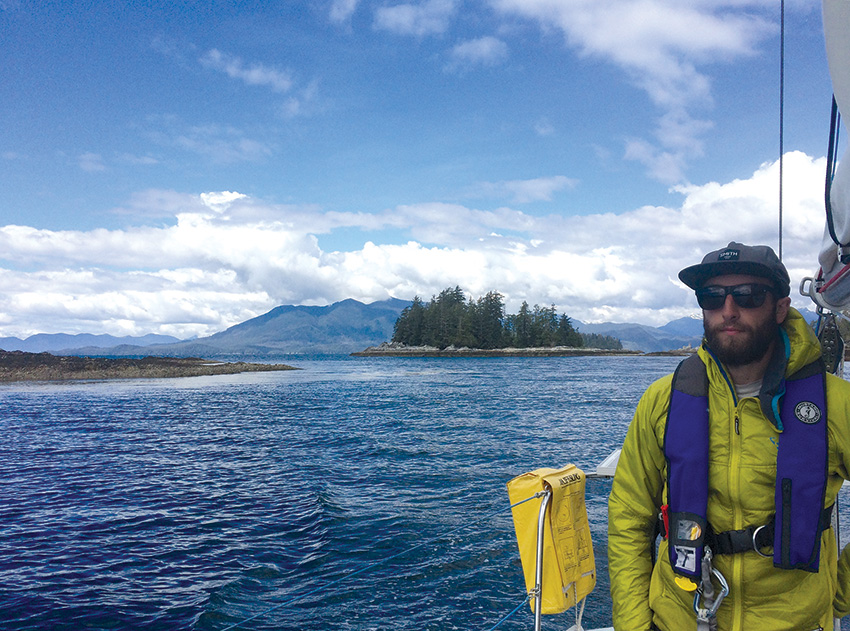
This means that only two options for anchorage exist on your way to the west coast: Sooke and Port Renfrew. Sooke is a strange little bit of suburban Victoria, with derelict docks and unwelcoming local wildlife. Expect to compete with angry geese, and possibly deranged harbor seals, for access to shore power. There is one great reason to stop in Sooke, however: the marina shower has no timer on it. Port Renfrew is a bit more welcoming, with a decent pub. Unfortunately, all the docks are removed for the winter, and you’ll have to anchor. The most sheltered spot is inside the Pacific Gateway marina basin.
We had picked our way out the Strait of Juan de Fuca to Bamfield, and from there into the Broken Group to explore. We saw no other cruisers. However, numerous sportfishing boats danced in and out of the rocky coast, bobbing dramatically near curling reef breaks. The edge of your world is usually the center of someone else’s, and the locals of Barkley Sound seemed to crab, fish, and shrimp on all but the worst days.
The Sound is also littered with relics of previous inhabitants. The exorbitant growth of the rainforest, and the extremity of the weather, means that some human marks disappear quickly. The cruising guide describes ancient stone fish traps as being clearly visible in some coves. We never saw one, despite rowing around for hours, trailing a posse of curious (hungry?) seals. But humans have been trying to make a living from the land for a long time there. Modern impacts are harder to miss. An abandoned mansion/lodge looms over Robber’s Passage on Tzartus Island, broken windows eyeing the outer reef break. Logging scars rake the hillsides. Beachcombing is fertile, with everything from delicate corals to plastic barrels, to smashed chunks of boats. Nothing will make you consider the relative frailty of fiberglass like seeing an 8-foot-wide transom in a spruce tree.
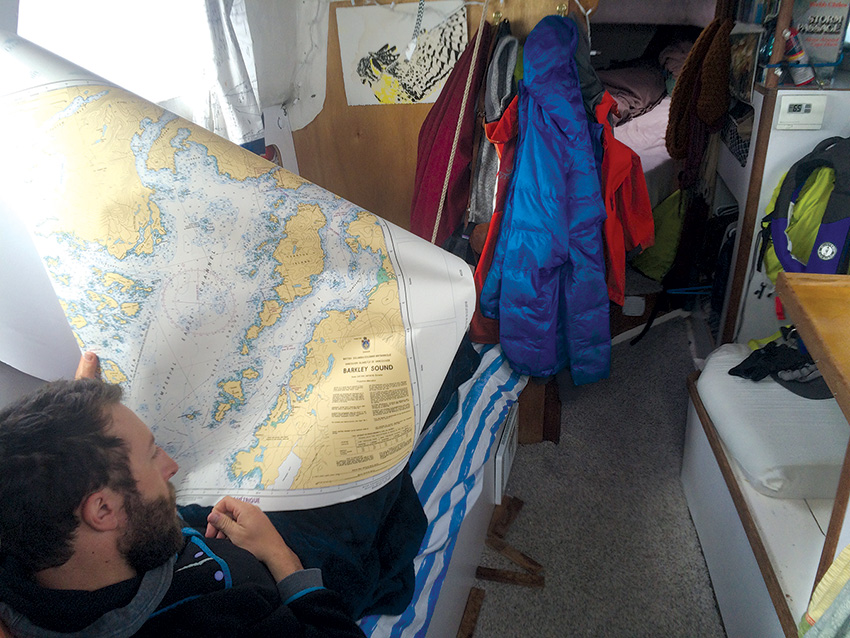
We had been waiting out a storm at Effingham Bay in hopes of sailing farther north, but were increasingly aware of the short time window we had to push on and still make it back to Seattle. After pulling the anchor, we poked our noses out into Loudon Channel.
Never had we decided to end a sailing trip so quickly. We had put the jib up for maybe five minutes when we realized the size of the swell that the storm had brought and left behind. We hadn’t seen from our sheltered nook the amount of wind and wave action remaining outside. The complex terrain of reefs and rocks between us and Ucluelet was generating huge breakers, even inside of the initial outer reef break. Stay in the deep water, and you merely got a fun ride over the long swells. Find the wrong wave in the wrong shallow spot… we turned around and looked for another island to explore.
While the swells of the Pacific may make you wish you were in the largest craft possible, the Broken Group is a world in miniature. Each tiny island looks like its own Bonsai arrangement, densely packed with driftwood, gnarled trees, and dangling moss. The closer you approach to each island, the greater the detail that emerges. The smaller the boat, the nearer you can get to the sea caves, small nooks, and fascinating detail of the islands. A shallow draft is also helpful to work your way around the many fiberglass-hungry humps and reefs.
While the outer coast is a great test-run for bluewater dreamers, the option to trailer a boat to Port Alberni would provide an excellent option to explore in even the smallest sailboats. However you get there, enjoy the adventure. And, do your best to catch a sightseeing tour aboard the Black Pearl.

